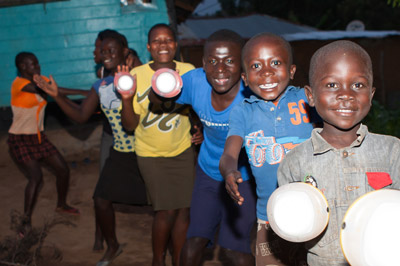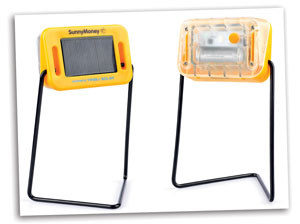SolarAid and Yingli Green Energy first joined forces to try and deliver the most affordable solar light to Africa in 2014. SolarAid’s feedback from the field, based on many thousands of interview interactions, was that low cost was the single most important consideration for potential buyers. There were also other important considerations, all of which we fed into a brief for UK design agency inventid. The SM100 was the result.
 A key consideration was holistic economics. The light had to be as affordable as possible, but we had to leave room for a two workable elements of profit: what the business folk call ‘margins’. One margin would be at Yingli, so their solar lighting unit could live on to design and manufacture more solar lights, including ever more affordable ones. The other margin would be for the distributors of SolarAid’s retail brand SunnyMoney, so that genuine livelihoods could be created in Africa. Only SolarAid could ‘afford’ to take no profit, once all the accounting is done, because we are a charity with a mission to eradicate the kerosene light across Africa, by reaching people living in remote rural areas and catalysing solar lighting markets across the continent. With all this in mind, our instruction to inventid was to design a product that would retail in Africa, to the end user, for $5. They did this so well that they are now shortlisted for a top design award.
A key consideration was holistic economics. The light had to be as affordable as possible, but we had to leave room for a two workable elements of profit: what the business folk call ‘margins’. One margin would be at Yingli, so their solar lighting unit could live on to design and manufacture more solar lights, including ever more affordable ones. The other margin would be for the distributors of SolarAid’s retail brand SunnyMoney, so that genuine livelihoods could be created in Africa. Only SolarAid could ‘afford’ to take no profit, once all the accounting is done, because we are a charity with a mission to eradicate the kerosene light across Africa, by reaching people living in remote rural areas and catalysing solar lighting markets across the continent. With all this in mind, our instruction to inventid was to design a product that would retail in Africa, to the end user, for $5. They did this so well that they are now shortlisted for a top design award.
 When we launched the SM100 in October 2016, our review of the market showed that it was the most affordable quality light. But things move on with competition, and that is nothing but good. We still believe it is the most affordable light, if the need for a sustainable margin is factored in. Some lights may be able to beat us on price if manufacturers do not factor in the enough margin to allow a sustainable long-term business model.
When we launched the SM100 in October 2016, our review of the market showed that it was the most affordable quality light. But things move on with competition, and that is nothing but good. We still believe it is the most affordable light, if the need for a sustainable margin is factored in. Some lights may be able to beat us on price if manufacturers do not factor in the enough margin to allow a sustainable long-term business model.
Then there is quality. We apply our affordability criteria only to quality-verified products, of which SM100 is of course one, which have been certified as meeting Lighting Global quality standards. Of course some solar lights that do not meet these criteria, or are even manufactured by people who know they won’t work for long. They can beat us on retail price. But of course they can never beat us, or any companies selling quality-verified lights that last a long time, on whole-life economics, including the costing of savings consumers make on kerosene no longer needed.
The other variable when talking about affordability is taxes. We retail the SM100 for $5, but that excludes the import tariffs & duties that countries including Malawi and Uganda apply. We need to compare apples with apples, not apples and pears, so this has to be borne in mind too when comparing product prices. SolarAid works actively with GOGLA and Power For All on trying to reduce and remove import tariffs.
We are still undergoing ramp-up in demand and production of SM100 to continue to bring bring down the SM100’s cost via manufacturing-at-scale efficiencies, and by optimising our supply chain. So our goalposts will move for the good. But of course we know that other manufacturers will compete with us, innovate, and make progress. As soon as we hear of a quality-verified light that is not being sold as a “loss leader”, i.e. whose price includes workable margins, then we will change our rhetoric from “most affordable light” to “one of the most affordable lights”. We will be happy to do this given our mission, and what we know of the vital importance of low cost to the future of the solar lighting industry.
Jeremy Leggett
UPDATE: 27 June 2017
In some territories of some African countries, via some sales channels, it is now possible to buy other Lighting Global Certified solar lights for less than the SM100. SolarAid is pleased to have held the title of “world’s most affordable light” but recognise there are now other affordable solar lights. The more affordable our industry’s products become, the more African people will be able to afford them.